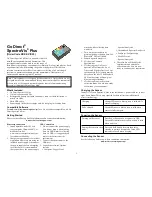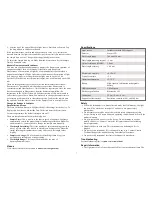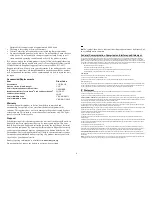
2
3. Fill a cuvette about 3/4 full with distilled water (or the solvent being used
in the experiment) to serve as the blank. After the Spectrophotometer has
warmed up, place the blank cuvette in the Spectrophotometer. Align the
cuvette so the clear side of the cuvette is facing the light source. Click or tap
Finish Calibration.
4. You are now ready to collect data. Fill a cuvette about 3/4 full of a sample
of the solution to be tested. Place the sample in the Spectrophotometer and
click Collect. Click Stop to end data collection. The spectrum is
automatically stored.
Measurement
vs.
Concentration (Beer's law)
1. Select Measurement
vs.
Concentration.
2. The calibration dialog box will appear. The warm-up timer starts counting
when the spectrometer connects to the platform. As a result, the countdown
may appear to vary. The minimum warm-up time is 90 seconds. For best
results, we suggest a warm-up time of several minutes.
3. Fill a cuvette about 3/4 full with distilled water (or the solvent being used
in the experiment) to serve as the blank. After the Spectrophotometer has
warmed up, place the blank cuvette in the Spectrophotometer. Align the
cuvette so the clear side of the cuvette is facing the light source. Click or tap
Finish Calibration.
4. Follow the instructions in the Choose a Wavelength dialog box or simply
type in the wavelength you wish to measure. Select Done.
5. Click Collect. Your first sample should still be in the Spectrophotometer.
After the reading stabilizes, click Keep. Enter the concentration of the
sample and click or tap Keep Point.
6. Place your second sample in the cuvette slot. After the reading stabilizes,
click Keep. Enter the concentration of the sample and click or tap Keep
Point.
7. Repeat Step 6 for the remaining samples. When finished, click Stop to end
data collection. The data is automatically stored.
8. To see the best fit line equation for the standard solutions, click Graph
Tools, select Apply Curve Fit, and choose Linear. Click or tap Apply.
9. If doing Beer's law to determine the concentration of an unknown, place the
unknown sample in the cuvette holder. Click or tap Graph Tools and enable
Interpolate. Click or tap along the line until you find the concentration
value that matches your unknown's measurement.
10. Save or export your data from the File menu.
Measurement
vs.
Time (Kinetics)
1. Select Measurement
vs.
Time.
2. The calibration dialog box will appear. The warm-up timer starts counting
when the Spectrophotometer connects to the platform. As a result, the
countdown may appear to vary. The minimum warm-up time is 90 seconds.
For best results, we suggest a warm-up time of several minutes.
3. Fill a cuvette about 3/4 full with distilled water (or the solvent being used
in the experiment) to serve as the blank. After the Spectrophotometer has
Connecting via Bluetooth
Ready to connect
Press Power button once. Blue LED next to
Bluetooth icon flashes when sensor is ready to
connect.
Connected
Blue LED next to Bluetooth icon is solid when
sensor is connected via Bluetooth wireless tech-
nology.
Connecting via USB
Connected and charging
Orange LED next to battery icon is solid when
sensor is connected to Spectral Analysis via
USB. LED next to Bluetooth icon is off.
LED next to power is solid green. LED next to
USB icon is solid green.
Connected, fully charged
LED next to battery icon is off when sensor is
connected to Spectral Analysis via USB and
fully charged. LED next to Bluetooth icon is off.
Charging via USB, con-
nected via Bluetooth
This combination is not permitted.
Charging via AC power,
connected via Bluetooth
This combination is not recommended.
Using the Product with Spectral Analysis 4
Connect the sensor following the steps in the Getting Started section of this user
manual.
Collect Data with Spectral Analysis 4
The three options for Experiment Types are:
1. Measurement
vs.
Wavelength—collect a full spectrum.
2. Measurement
vs.
Concentration—conduct a Beer's law experiment.
3. Measurement
vs.
Time—collect time-based data for a kinetics experiment.
By default, Absorbance is selected. If you want to measure %Transmittance, use
the toggle switch.
Note:
Visit
www.vernier.com/spectral-analysis
for status of
intensity and fluorescence support.
Measurement
vs.
Wavelength (Full Spectrum)
1. Select Measurement
vs.
Wavelength.
2. The calibration dialog box will appear. The warm-up timer starts counting
when the Spectrophotometer connects to the platform. As a result, the
countdown may appear to vary. The minimum warm-up time is 90 seconds.
For best results, we suggest a warm-up time of several minutes.









